Critical Details Of Design Planning Your NYC Apartment Renovation
Flawless design in your NYC renovation hinges on thorough upfront planning, plus a partner who can help guide the process.
October 16, 2024
|

Critical Details Of Design Planning Your NYC Apartment Renovation
Flawless and functional interior design during your NYC renovation doesn't come without detailed consideration beforehand.
Table of contents
- The Hidden Complexities of Kitchen Design
- Bathroom Renovations: When Size Matters
- The Ripple Effect: Electrical Planning and Beyond
- Balancing Aesthetics and Functionality
- Common Pitfalls and How to Avoid Them
When planning a New York City apartment renovation, best case scenario is only achieved with proper foresight. This is especially the case when considering how the unique existing conditions of your residence can influence your proposed design choices, whether in subtle ways or through major adjustments that affect the overall interior design strategy. For some, small sticking points may need to be considered in efforts to ensure no last minute hiccups occur during build. For others, critical layout updates and subsequent electrical rewiring may necessitate changing a design-centric renovation to a full gut renovation. In both cases, understanding what to anticipate beforehand is crucial. That’s why we’ve outlined the key details of design planning for NYC apartment renovations below. With a proactive strategy and the right partner, your renovation will make the most of your home’s square footage.

[#1]The Hidden Complexities of Kitchen Design[#1]
Considering the kitchen is often the first room considered for NYC renovations, let’s start by outlining hidden complexities we often see on the job and have accounted for when helping clients with their interior design planning.
The Importance of Gas Valve Placement in NYC Kitchens
In NYC apartments, where every square foot is at a premium, even the smallest design detail can have a massive impact on the final result—especially when it comes to kitchen layout. One often-overlooked detail is the placement of the gas valve. The positioning of the gas valve dictates the placement of key appliances like your stove or range. If the valve is in a less-than-ideal spot, you may find your dream layout compromised. This could mean sacrificing counter space, or even ending up with a stove that awkwardly interrupts the flow of the room.
That’s why careful pre-planning is essential. You need to ensure that gas lines and valves are positioned in a way that both supports your layout vision and adheres to city safety codes. Keep in mind that relocating a gas line in NYC isn’t simple and many times outright impossible. The process involves securing permits, working with certified professionals, and coordinating with your building’s management.
NYC Apartment Kitchen Layout Options
Given the space constraints of many NYC apartments, kitchen layouts tend to fall into a few common categories, each with its pros and cons:
-min.jpeg)
Galley Kitchens
A galley kitchen features two parallel counters with a walkway in between. This layout works well in narrow spaces and offers plenty of countertop and storage areas. However, it can feel cramped, especially if multiple people are cooking at once. In NYC’s typical pre-war apartments, this layout is often the most practical choice for maintaining flow while maximizing functionality. An example of a galley kitchen can be found in our downtown Brooklyn co-op gut renovation, where the client specifically requested a custom galley in order to provide some separation when cooking with guests over.
-min.jpeg)
L-Shaped Kitchens
The L-shape is great for making the most of corner spaces, and it’s ideal for open-plan apartments. It creates a natural flow between the kitchen and the rest of the living area. However, the lack of wall space for cabinets might require creative storage solutions. In smaller apartments, the L-shape can eat into your living room space if not carefully planned. An example of an L-shaped kitchen can be seen in our boutique co-op renovation in Manhattan at 230 E 50th st, which carries a traditional design vision, favoring soft colors, especially blues and grays, along with natural materials like marble.

U-Shaped Kitchens
U-shaped kitchens offer ample workspace and storage, making them highly functional. However, this layout requires more square footage and can be challenging to fit into smaller apartments. Still, for larger apartments or renovated brownstones, the U-shape offers efficiency without sacrificing aesthetic appeal. With over 4,000 square feet of space, there was enough room for a U-shaped kitchen in our full renovation of the pre-war co-op in Manhattan at 1035 5th Avenue, which we also equipped with a beautiful breakfast nook.
Tips for Maximizing Kitchen Functionality in NYC
With an understanding of the obstacles you may be required to work around, you’ll now need to know to accommodate accordingly. Here are tips to strike a balance between style and practicality for an ideal kitchen UX:
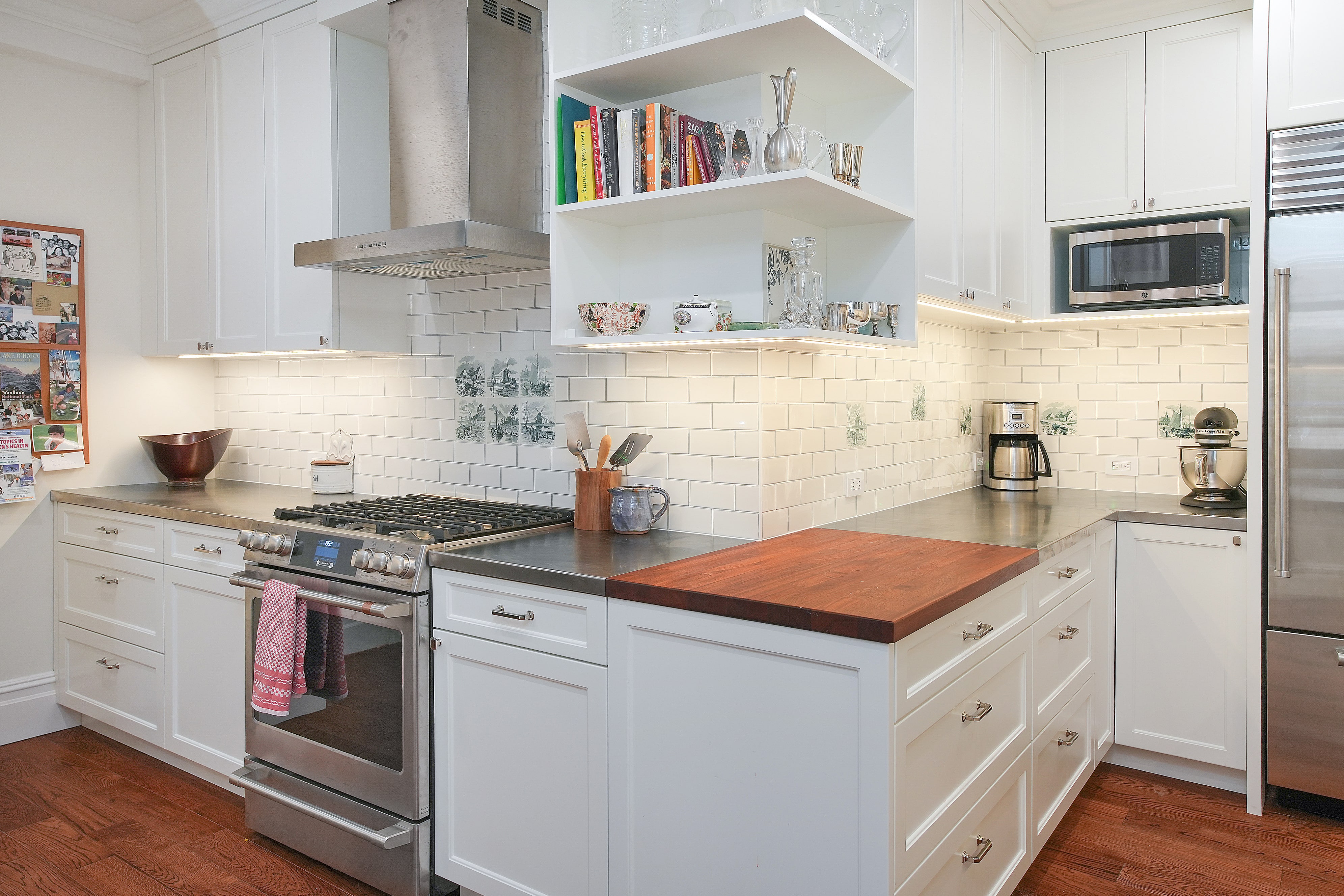
Opt for Multifunctional Elements
Consider incorporating multi-use pieces like a kitchen island that doubles as a dining table or a cutting board that fits over the sink. In a small kitchen, having an island with built-in storage can save valuable cabinet space without compromising style. In our Manhattan apartment renovation at 91 Central Park West, we helped the client make the most of their space by incorporating commercial-grade elements throughout the space.
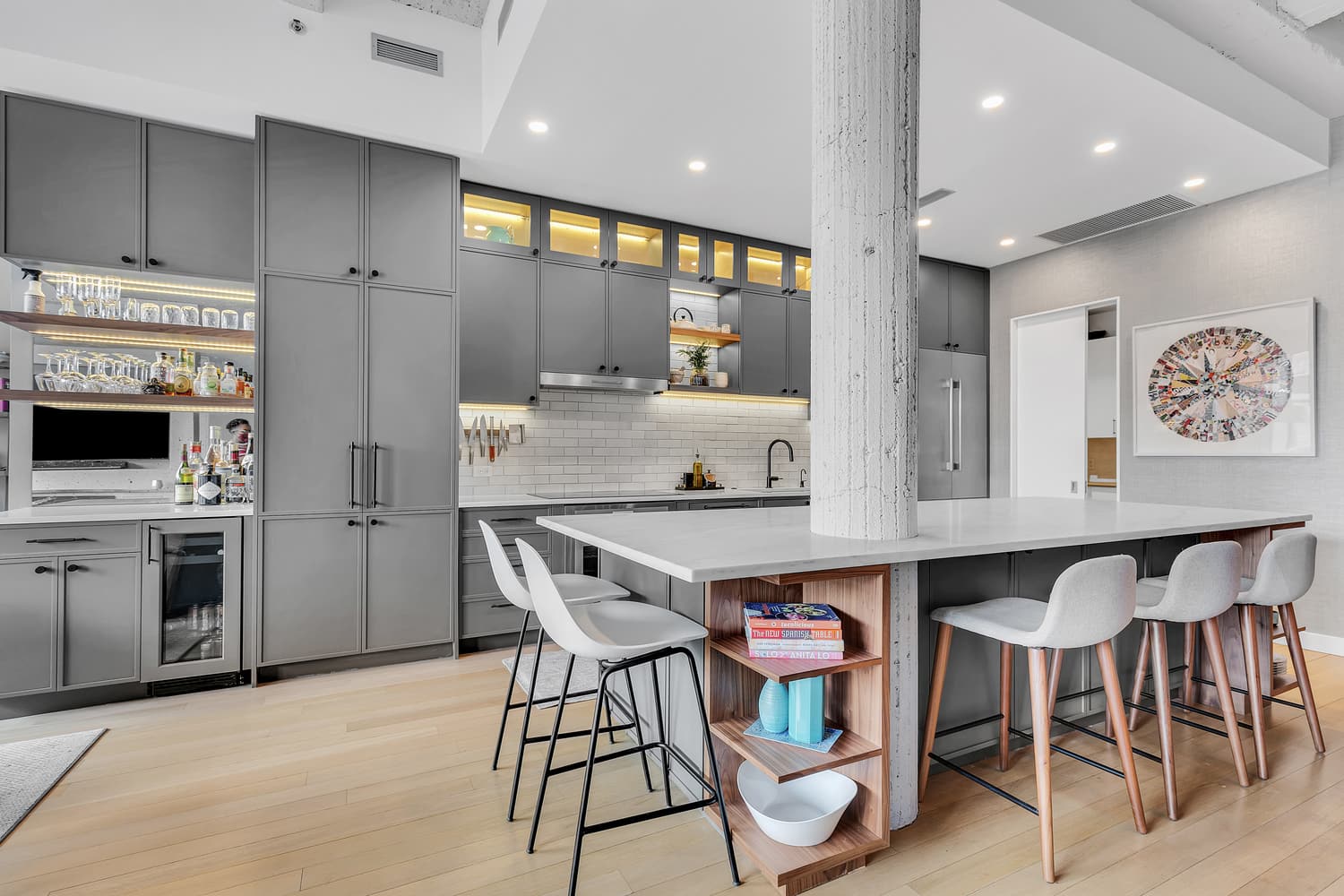
Go Vertical
One often underused aspect of kitchen design is vertical space. Custom shelving and cabinetry that stretch up to the ceiling can maximize storage in even the smallest apartments, or elevate the design of larger ones (see our Manhattan loft kitchen renovation at 419 West 55th). Just be sure to store lesser-used items in higher places to maintain easy access to everyday essentials.
-min.jpeg)
Integrated Appliances
Built-in, or panel-ready, appliances help streamline the look of your kitchen while saving space. Consider a fridge that blends into your cabinetry or a dishwasher drawer instead of a traditional door. For instance, see how we blended the fridge into the MCM design of our UES co-op renovation at 55 East End Ave. In NYC apartments, where every foot counts, the sleek, flush finish of integrated appliances can make a kitchen feel larger and more cohesive.
[#2]Bathroom Renovations: When Size Matters[#2]
In bathrooms throughout NYC's countless apartments and co-ops, size comes at a premium. That's why prioritizing planning up front in areas like tile work, layout, lighting and more is a must.
.jpeg)
Tile Size and Bathroom Dimensions
When considering bathroom renovations in NYC apartments, tile selection plays a pivotal role in the overall perception of size. The relationship between tile size and bathroom dimensions is something that can drastically alter how the room feels. Larger tiles, for example, create fewer grout lines, which can give the illusion of a more expansive floor or wall (see the main bath design from our Manhattan condo renovation in The Chelsea Mercantile at 252 Seventh Ave). In a small NYC bathroom, this can be a game-changer, tricking the eye into seeing a more open, airy space.
However, large tiles in very tight spaces can sometimes feel overwhelming if not balanced with other design elements. On the flip side, small mosaic tiles can add texture and detail but may make the room feel busier or more compact. The key is finding the right balance between tile size and the overall layout of your bathroom.
.jpeg)
Tile Placement Techniques and Spatial Perception
Beyond size, the placement of tiles can significantly impact how spacious (or cramped) a bathroom feels. Here are a few techniques commonly used in NYC apartments:
Horizontal Layouts
Laying rectangular tiles horizontally can elongate the walls and make the room feel wider than it is, which is especially helpful in narrow bathrooms.
Vertical Layouts
On the other hand, vertical tile placement can draw the eye upward, making the ceiling seem higher and giving a sense of greater height in low-ceilinged bathrooms often found in pre-war buildings.
Diagonal Placement
For floors, a diagonal tile pattern can create the illusion of more space by softening the room’s boundaries, making the floor seem larger than it is. This trick works particularly well in cramped NYC bathrooms, where every inch counts.
.jpeg)
Design Tactics for Enhancing Bathroom Proportions
In a compact NYC bathroom, you want to maximize every inch without cluttering the space, as we outlined in our blog, 6 NYC Small Bathroom Remodel Ideas Sure To Change Your Life. Here are a few additional design tactics that can enhance the room’s proportions:
Reflective Surfaces
Incorporating reflective materials, such as high-gloss tiles or large mirrors, can make the room feel larger by bouncing light around the space. Mirrors placed opposite windows can also amplify natural light, further brightening up smaller bathrooms.
Light Color Palettes
Lighter shades of tile—think whites, creams, or soft grays—help make the room feel more open. Darker tiles, while dramatic, tend to absorb light and can make a small bathroom feel even more compact. See the light and classic feel we gave to our Tribeca ensuite bathroom renovation at 9 Murray St.
Floating Fixtures
Opt for floating vanities and wall-mounted toilets, which create more visible floor space and give the illusion of a larger room. These elements are especially useful in NYC bathrooms where storage is key, yet space is limited. See how we implemented floating toilets throughout the bathrooms of our Manhattan loft renovation in Tribeca at 73 Worth St.
.jpeg)
[#3]The Ripple Effect: Electrical Planning and Beyond[#3]
Those following along at our Design & Reno Blog know we aim to outline various considerations prior to renovating in NYC - including insights into your electrical systems. Here are a few key takeaways:
The Importance of Comprehensive Electrical Planning
Electrical planning is often an afterthought in apartment renovations, but definitely deserves more time to shine. In NYC, where layouts can be tight and electrical systems outdated, taking the time to thoroughly plan your electrical setup is critical. Thoughtfully placed outlets are a prime example. Think about how frustrating it can be to end up with a beautifully renovated kitchen, only to realize there’s no convenient outlet for your coffee maker. Or imagine your living room without a proper place to plug in your floor lamp. Outlets should be positioned based on how you use your space now, but also with an eye toward the future—whether that means accommodating more tech or anticipating evolving appliance needs.
Future-proofing your electrical system also involves ensuring the capacity can handle future demands. With NYC apartments, you often deal with older wiring that might not be ready for the load of today’s devices, let alone tomorrow’s. Upgrading panels and adding circuits during renovations can save you from costly electrical overhauls down the line. For tips on how to gauge your home’s electrical system, read our blog, The Key To Assessing Your NYC Apartment's Electrical Needs For Renovation.
The Unintended Consequences of Structural Changes
Structural changes may seem like a simple matter of tearing down walls to open up space, but they often come with unexpected ripple effects. For instance, opening up a wall might reveal wiring that doesn’t meet current code standards, or it could expose plumbing or HVAC elements that were hidden behind the drywall. These surprises delay your renovation and stretch your budget.
As we discussed in our blog Common Surprises When Renovating A NYC Apartment, older buildings often have hidden asbestos or lead upon opening up walls, especially in pre-war buildings. This requires immediate mitigation efforts, which complicates both the timeline and the scope of your project. Structural modifications also affect load-bearing walls, and any changes there will require an engineer’s approval—not to mention city permits.
Maintaining Lighting Symmetry in the Face of Change
One of the biggest challenges during a renovation is keeping your lighting balanced after structural changes. When you open up walls or change room layouts, your old lighting plan might no longer work. For example, recessed lights that once lined a narrow hallway perfectly could suddenly seem oddly spaced in a new, more open layout. Or, pendant lights in a kitchen might no longer align with the center of the island after shifting the layout to accommodate new cabinetry.
To maintain visual balance, adapt your lighting to the new space rather than forcing the old plan to fit. You might need to add new light sources or switch to more flexible lighting, like track lighting that can be adjusted to suit a new layout. Another option is layering different types of lighting—ambient, task, and accent—to ensure the space is both functional and visually harmonious.
Planning The Right Lighting
At Gallery, we always consider lighting best practices during all styles of our residential renovations, especially when adjusting the floor plan and making structural modifications. That’s why we have a detailed rendering process prior to any construction, which allows us clients to see life-like 3D rendering of what their renovated home would look like - in various lighting settings to boot. See kitchen renders from one of our many Brooklyn renovations below, which offer two different lighting scenarios.
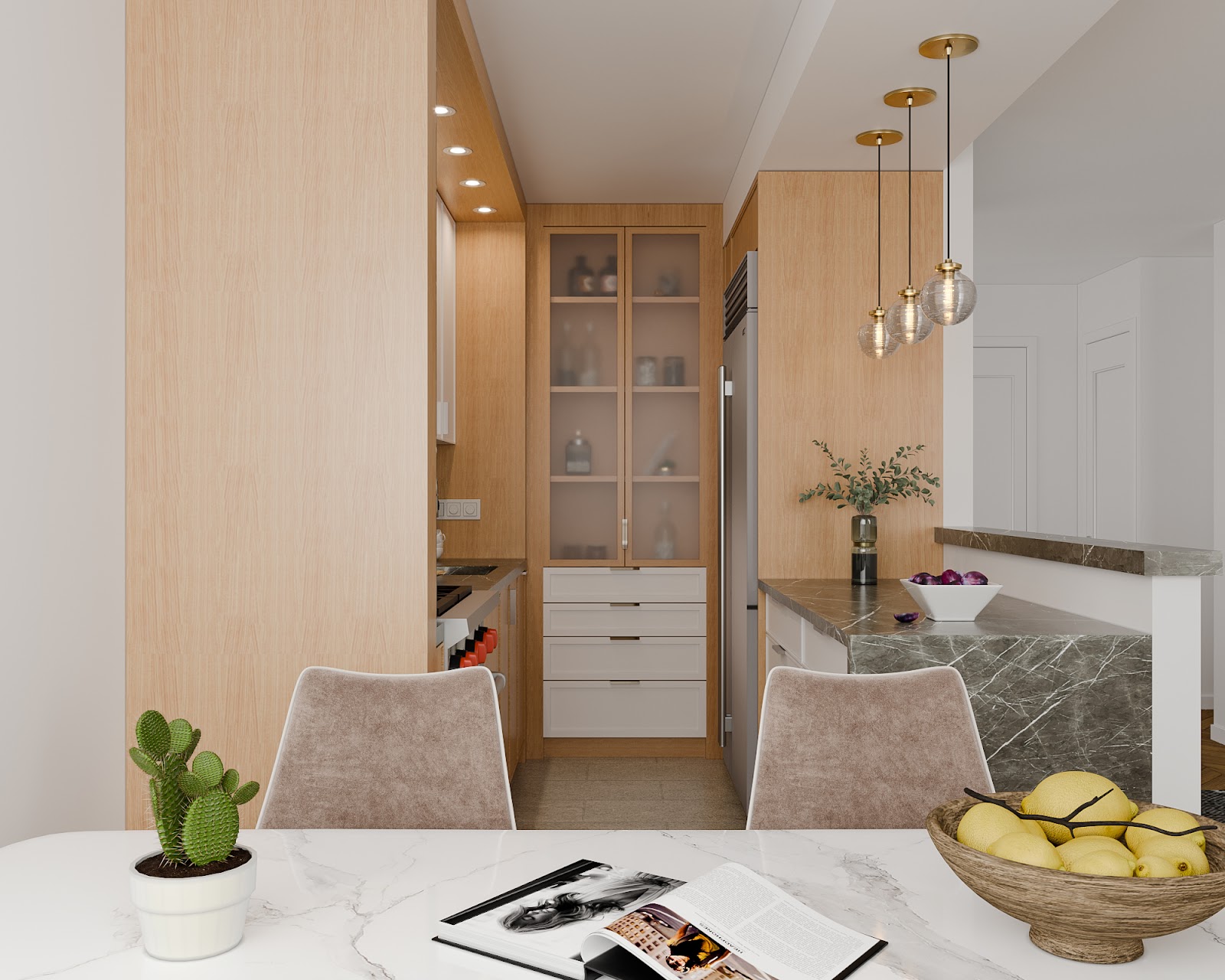

[#4]Balancing Aesthetics and Functionality[#4]
In any NYC apartment renovation, the challenge is finding the sweet spot where beauty meets practicality. A stunning kitchen may be IG-worthy, but without the right storage or flow, you’ll be freaking out within weeks. Balancing aesthetics and functionality means considering how you’ll use each space and how design decisions will either enhance or hinder that experience.
Minor Design Decisions with Big Impact
Every inch matters when renovating in NYC, so even the smallest design choices can have a major impact. Think about how awkward it is to deal with a bathroom door that swings into a tiny hallway, or how frustrating it can be to open a cabinet only to have it bump into the stove. A narrow hallway might seem insignificant until you’re trying to get groceries past your front door without knocking over your entry table.
Strategies for Blending Style and Practicality
When choosing between aesthetics and function, the answer is rarely either-or. The key is to evaluate each design decision based on how it serves both purposes. Here’s how you can strike the balance:
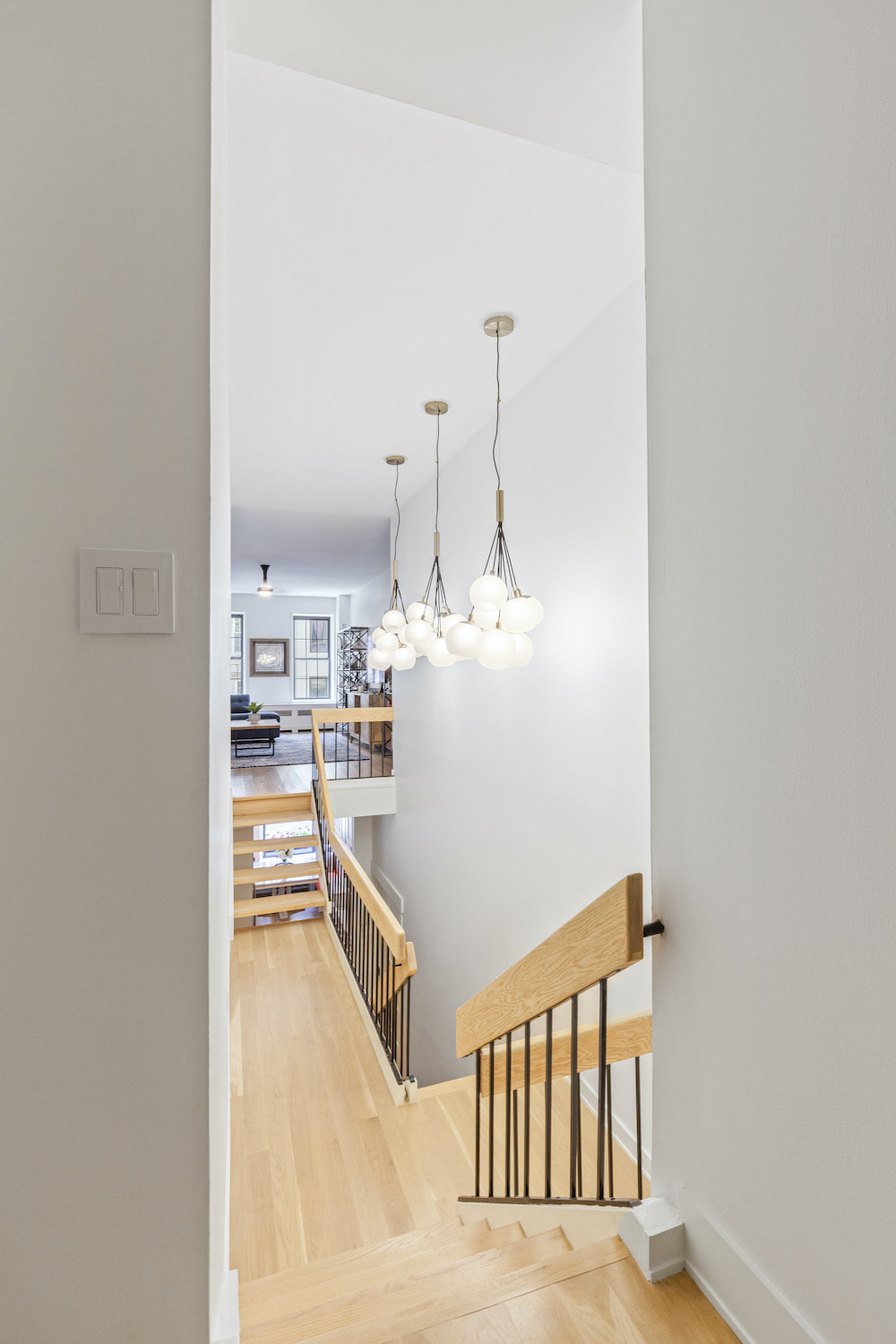
Prioritize Function in High-Traffic Areas
In NYC, the luxury of space is rare, so be prepared to prioritize practical needs in high-traffic areas—like the kitchen, bathroom, and entryway. For example, on stairs, the material you choose not only needs to match the rest of your home’s aesthetic, it needs to be durable. In these instances, opt for hardwood or engineered wood that can withstand heavy use. For our Manhattan Townhouse Renovation at 529 East 87th, we chose to maintain and refinish the original hardwood floors on the lower level, then update the flooring upstairs with a matching species of 4” white oak. Read more about the best flooring for NYC renovation via our blog, What Type Of Flooring Is Best For My NYC Renovation?
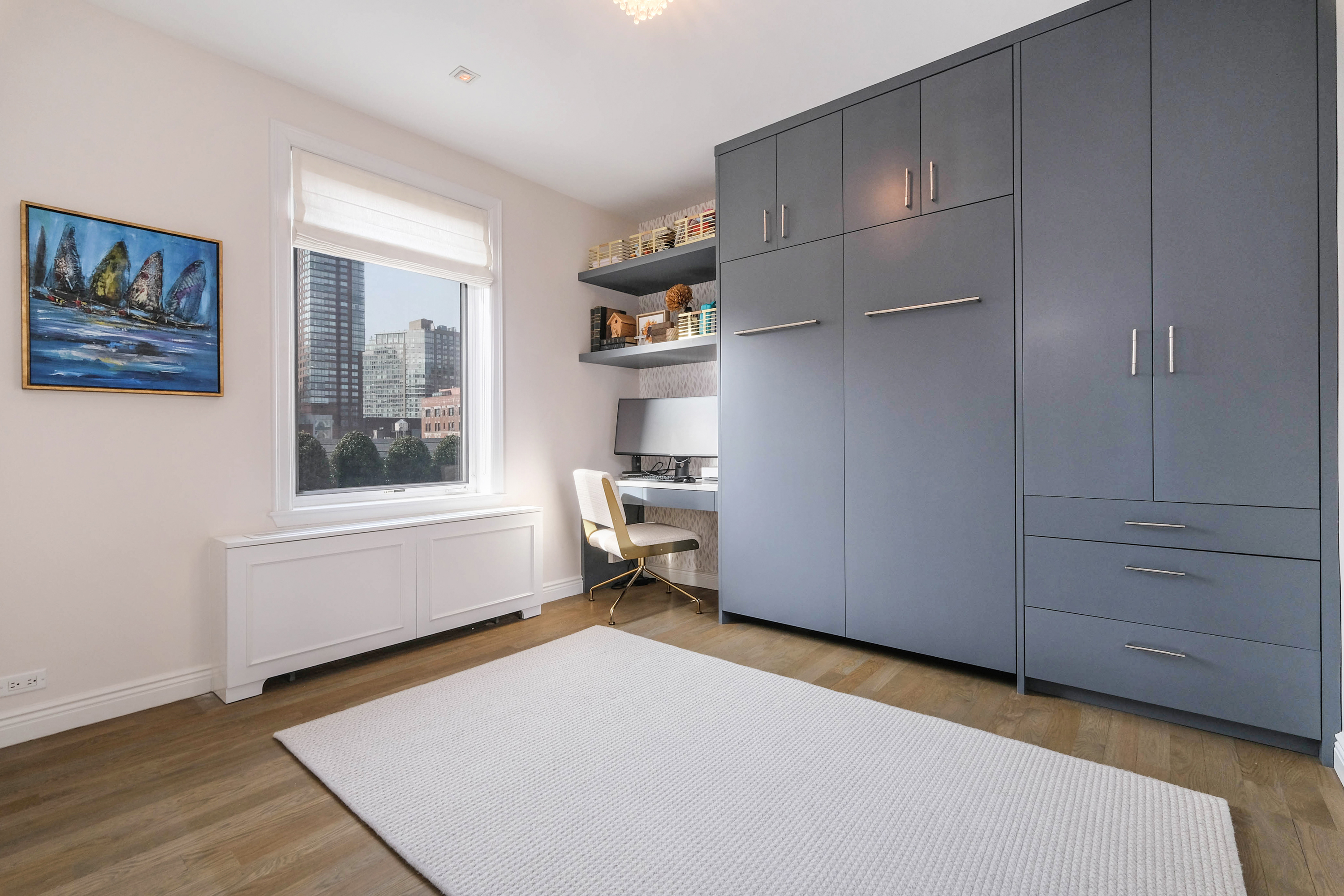
Consider Multi-Functional Furniture
Space-saving solutions like Murphy beds, fold-out desks, or extendable dining tables are a great way to incorporate style and function. In a small bedroom, a bed with built-in storage underneath can eliminate the need for a bulky dresser, freeing up valuable floor space while still looking sleek. For our Upper West Side Condo Renovation at 59 W 71st, we had a client who wanted to turn her guest bedroom into a formal office, but not sacrifice the bedroom aspect of the room. To compromise, our CEO Avi came up with a plan to create a custom Murphy bed with attached millwork that offers a built-in desk setting. View the full renovation before and after.

Compromise Wisely
Sometimes, you’ll face tough choices between your aesthetic preferences and what’s functionally practical. To strike a balance, consider compromising on non-essential design elements. For example, you might love a large farmhouse sink, but in a tiny kitchen, a smaller, under-mount sink with more counter space might make your daily life easier while still looking stylish.
By finding harmony between form and function, you not only create a beautiful apartment but one that serves your lifestyle for years to come as you grow into the space.
[#5]Common Pitfalls and How to Avoid Them[#5]
Without proper support from an experienced general contractor in Manhattan or Brooklyn, even the most well-intentioned NYC renovations can go awry. Let’s dive into some of the most common pitfalls and how you can steer clear of them.
Budget Miscalculations
- Mistake: Underestimating the true cost of a renovation is one of the most frequent—and costly—errors. In NYC, hidden costs like permit fees, unforeseen structural issues, and higher labor rates can quickly balloon your budget.
- Solution: Start by creating a detailed budget that accounts for everything: materials, labor, permits, and potential contingencies (usually around 10-20% extra). Get multiple quotes and make sure each contractor provides a thorough cost breakdown. Also, take your building’s specific rules into account—some co-ops or condos may have renovation surcharges or other requirements. To get ahead of the budgeting process, read our blog, NYC Apartment Renovation Costs In 2024: Costs Per Square Foot.
Overlooking Building Regulations
- Mistake: NYC’s stringent building codes and regulations can derail your project if they’re not considered from the start. Many owners underestimate the impact of things like zoning laws, electrical and plumbing codes, and building permits.
- Solution: Early consultation with a qualified architect or full-service design build firm like Gallery who knows NYC’s regulatory landscape is essential. Research Department of Buildings (DOB) regulations and ensure that all the required permits are filed before starting any work. Also, factor in your building’s approval process, which can take several months if you live in a co-op. For a heads up on the regulations and approvals surrounding your NYC renovation, read Tips To Ensure A Smooth Building Permit Approval Process For New York City Renovations.
Unrealistic Timelines
- Mistake: Thinking the renovation will be quick and straightforward is another classic blunder. NYC renovations, especially in older buildings, tend to take longer than anticipated, often due to unexpected issues like outdated plumbing or electrical systems.
- Solution: Plan for delays by building a flexible timeline. Work backward from when you’d like the project completed, leaving buffer time for unforeseen setbacks. Create a room-by-room renovation checklist that includes every task from demolition to finishing touches, and collaborate closely with your contractor to stay on track. To get an understanding of the timeline for your renovation, read the NYC Renovation Timelines section of our Design & Reno Blog.
Not Considering Future-Proofing
- Mistake: Making design decisions that work for today but may not be functional for the future is a pitfall many homeowners fall into, especially when considering layouts or electrical setups.
- Solution: Future-proofing your renovation means thinking ahead. This could include adding extra electrical outlets in convenient locations, opting for smart home features, or choosing materials that can stand up to wear and tear. It’s especially important in NYC where space is at a premium, and moving is not always a simple solution.
Why A Full-Service Partner Is Preferred When Design Planning Prior To Your NYC Renovation
As you can see, there are various reasons to be proactive when considering the design strategy prior to renovating your NYC apartment. However, with various components, the path of least resistance for busy New Yorkers is often the all-inclusive approach delivered by a full service design build general contractor.
Considering an apartment renovation in New York City? View our portfolio of NYC apartment renovation before and afters, learn more about Gallery, or contact us today.
We are an award-winning design-build firm in New York City with a full-service approach to renovations in Manhattan and Brooklyn that includes everything from interior design and architecture services to board approvals + permits and construction site management. We’re experts in pre-war apartment renovations, apartment combinations, room creations, full gut renovations and all that falls in between. Let us bring your dream home to life.

.png)
.png)





.jpg)

%20(2).jpg)


.jpg)
%20Gallery%20KBNY.JPG)


